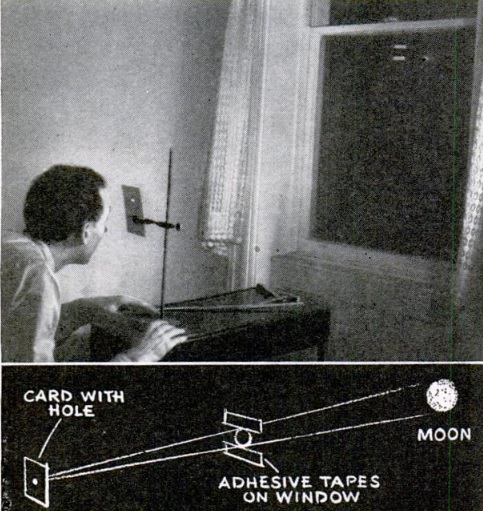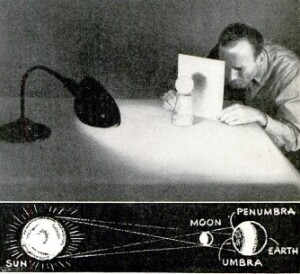 If Junior is looking for a science project that can be completed in one evening, the teacher will be suitably impressed when Junior announces that he will measure the diameter of the Moon. All that’s required is a window through which the moon is visible and a couple of pieces of tape. Masking tape would probably work the best, but you could also use a couple of Post-It notes. You’ll also need a card through which you cut a hole.
If Junior is looking for a science project that can be completed in one evening, the teacher will be suitably impressed when Junior announces that he will measure the diameter of the Moon. All that’s required is a window through which the moon is visible and a couple of pieces of tape. Masking tape would probably work the best, but you could also use a couple of Post-It notes. You’ll also need a card through which you cut a hole.
Place the strips of tape on the window 1-1/4 inches apart. Then, you move the card away from the window, and keep looking through it until the moon appears to fill the space between the two pieces of tape. Measure the distance between the card and the window. At this point, the proportion of the two distances is the same as the proportion between the moon’s diameter and the distance between the moon and the earth.
Let’s say, for example, that Junior measures the distance between the card and the window as 137-1/2 inches. (Ahem, and if he does the experiment correctly, that’s the number he should get, assuming that the moon hasn’t changed size.)
According to NASA, who has been there, the moon is 238,855 miles from the earth. So we have a ratio:
1.25 / 137.5 = X / 238,855
If Junior’s algebra is a little bit rusty, he can use this online calculator to get the answer of 2171.4 miles. According to space.com, the actual diameter is 2159.2 miles, so we would say that Junior’s method is pretty close.
 The experiment appeared 80 years ago this month in the February 1941 issue of Popular Science, which also carried some other astronomy experiments and demonstrations. For example, shown here is a demonstration of a solar eclipse, using a lamp for the sun and a tennis ball for the moon. One of these would be an excellent project in preparation for the June 10, 2021 annular eclipse or the April 8, 2024, total solar eclipse, both of which will be visible in North America. The magazine even shows how to demonstrate the orbit of a comet using an electromagnet to simulate the sun’s gravitational pull on a steel ball simulating the comet.
The experiment appeared 80 years ago this month in the February 1941 issue of Popular Science, which also carried some other astronomy experiments and demonstrations. For example, shown here is a demonstration of a solar eclipse, using a lamp for the sun and a tennis ball for the moon. One of these would be an excellent project in preparation for the June 10, 2021 annular eclipse or the April 8, 2024, total solar eclipse, both of which will be visible in North America. The magazine even shows how to demonstrate the orbit of a comet using an electromagnet to simulate the sun’s gravitational pull on a steel ball simulating the comet.
